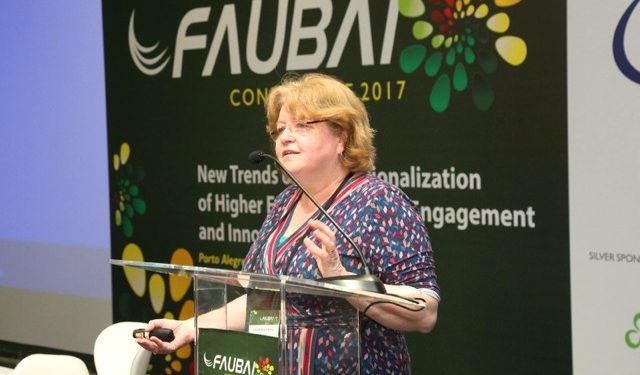The Coordination for the Improvement of Higher Education Personnel (CAPES), the Brazilian federal government HE funding and assessment body, recently announced the introduction of a new international mobility financing regime to replace the Ciências Sem Fronteiras (“Sciences without Borders”) initiative.
News and business analysis for Professionals in International Education
Have some pie!
Brazil unveils new HE internationalisation scheme
 Connie McManus Pimentel, director of international relations at the Coordination for the Improvement of Higher Education Personnel (CAPES), told delegates at the recent FAUBAI conference that the government's new scheme would focus on universities instead of mobility. Photo: FAUBAI
Connie McManus Pimentel, director of international relations at the Coordination for the Improvement of Higher Education Personnel (CAPES), told delegates at the recent FAUBAI conference that the government's new scheme would focus on universities instead of mobility. Photo: FAUBAI Mais Ciência, Mais Desenvolvimento- Johanna Döbereiner (“More Science, More Development”) will bring about profound changes in the structure and functioning of Brazilian federal funding and will grant more autonomy to Brazilian universities.
As a result of the political and economic upheaval of the past two years, Brazilian and international observers have had to pass through a period of intense uncertainty as to the future of higher education funding.
This confusion appears to be lifting now with the announcement of the new program, which is due to be published in full in July, in time for the second semester of the Brazilian academic year.
“The role that will be played by HEIs is the main advancement of the new program”
Compared to the centralised structure of CSF, where control over decision making was retained at the federal level, giving little autonomy to the university and therefore little contact between hosting and sending institutions, MSMD will require each individual university to form a coherent elaborated internationalisation strategy together with international partners in order to gain access to mobility funding.
The scheme represents a major departure for Brazilian public science funding, which has typically tended towards centrally administered funds going to individuals or individual departments.
It will undoubtedly be a test of many universities’ policymaking capabilities, but it will mean that in future universities will be much more able to engage in consistent and strategic way.
Universities have welcomed the new responsibility the program allots them. “The role that will be played by HEIs is the main advancement of the new program,” José Celso, president of Brazil’s international education association, FAUBAI, told The PIE News.
“The program will stimulate more comprehensive strategies and collaboration,” he added. “HEIs will have to be more proactive and more involved.”
The program has three primary goals: to improve Brazilian internationalisation, to enhance bilateral relationships with overseas partners, and to upskill graduate students who can bring their knowledge back to Brazilian higher education.
Although the final details are not yet published, it is expected that the guidelines for the quadrennial reports will contain plans for internationalisation of curricula (including English language delivery), staff attraction and retention and the development of strategic partnerships with foreign institutions.
Universities must submit their proposals by October, according to Celso. Funding for the scheme is expected to be finalised with Brazil’s 2018 budget.
In contrast with the CSF program, the bulk of funding for mobility will be specifically targetted towards postgraduate students and early career researchers looking to develop research abroad.
At FAUBAI’s annual conference this month, director of international relations at CAPES, Connie McManus Pimentel, explained, “Now, we will invest in institutions instead of investing in individuals. Universities will be the focus.”
She went on to say, “We will finance what they need to be better, thinking of different ways to do internationalisation.”
“Now, we will invest in institutions instead of investing in individuals”
In the short-term, this means that foreign universities wishing to form research partnerships would be well advised to contact Brazilian partner institutions in order to assist their attempts to gain funding.
They can also look forward to more structured and deeper relationships with Brazilian universities, albeit with a likely reduction in the number of incoming students compared to CSF.
In the medium to long-term, this should encourage Brazilian universities to coordinate on an institutional level, making them easier collaboration partners looking to engage in sustained inward and outward mobility programs.
Celso is optimistic it will improve those symmetrical partnerships with overseas institutions.
“Mobility should be framed through a bilateral partnership and seek to modernise the curricula of the Brazilian courses,” he said.
“This situation will require the foreign institutions to approach the Brazilian ones because, in the future, the financing for the internationalisation activities will be given mainly through these partnerships.”
Still looking? Find by category:



The best and simplest way will be:
1, Teach English to students and professors.
2. Invite good foreign teachers from around the world.